
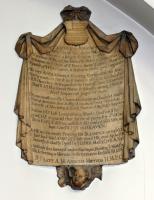
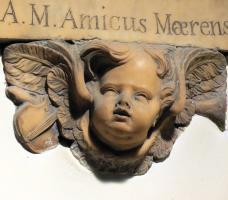
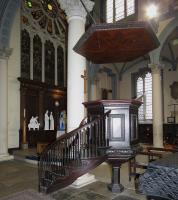
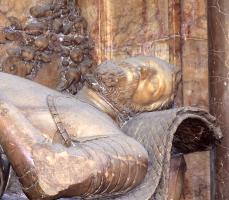
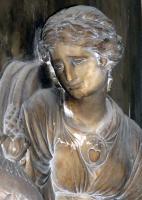
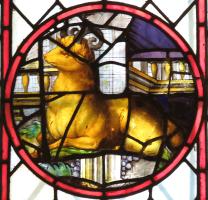
St Katharine Cree survived the Great Fire of London, and is of interest to these pages for its monument with effigy to Sir Nicholas Throkmorton, and 25-odd panel monuments including an early Classical one, four 18th Century cartouches, and from the end of that Century, a panel with a finely carved girl and pot by John Bacon RA. The Church stands in Leadenhall Street, just a few minutes walk from Bank Station and close to several other City Churches.
St Katharine Cree, 19th Century views and today. 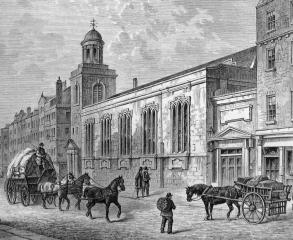
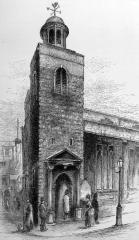
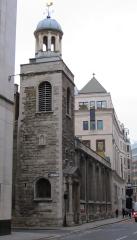
A few words on the Church building itself. In medieval times, St Katherine Cree stood in the cemetery of the Augustinian Priory of Holy Trinity, Christ’s Church, Aldgate – ‘Cree’ being supposed to be a contraction of 'Christ's Church'. On its dissolution in 1532, the grand Priory church was offered as a swap to the parishioners of St Katharine Cree, who unfortunately refused, and it was subsequently pulled down. St Katherine Cree was rebuilt from 1628-30, the first brick being laid by Martin Bond, whose fine monument is in St Helen Bishopsgate. The Church thus a rare Jacobean church ‘hybrid Gothic Classical’ design of the time of Bishop Laud, who consecrated it with an elaborate ceremony later used against him at his trial. Pevsner, the architectural historian, calls St Katherine Cree ‘the most important church in London between [Inigo] Jones and Wren. The tower is older, dating from about 1504 according to John Stow, writing in about 1598. From the outside we see this low, square-sided tower at the corner of Creechurch Lane, with a small cupola on top, dating from 1776 (after a donation by Sir John Percivall, Merchant Taylor), and one aisle running alongside Leadenhall Street; the clerestory of the nave can just be seen from the opposite side of the road. The very base courses of masonry are distinct, and are the foundations from the previous, medieval church.
The building is long, tall inside with a vaulted ceiling, and has a rose window or Catherine wheel high up at the East end, celebrated as being understood to be copied from that of Old St Paul’s Cathedral before it was consumed in the Fire. There is a clerestory to the nave, but the aisles are relatively tall too, and it is on their walls where the monumental panels can be found.
St Katharine Cree, interior views. 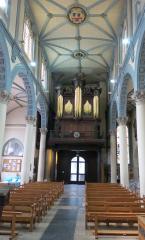
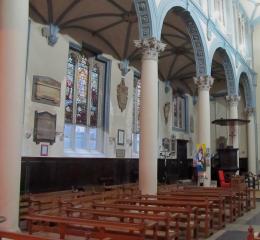
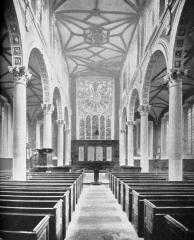
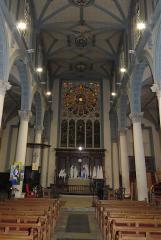
Sir Nicholas Throkmorton, d.1570. ‘Chief Butler of England, one of the Chamberlaynes of the Exchequier, Ambassador Lygyar to the Quene’s Majestie Quene Elizabethe....’. The chief monument in the Church, and like the tower, a survival from the previous church on the site.
We see the recumbent effigy of the much celebrated knight in pink alabaster, lying under a canopy supported by two Tuscan pillars, the inscription on the backing above the figure, surrounded with profuse festoons of carved flowers, strapwork and leafy, scrolly space-filling designs. Sir Nicholas is dressed in plate armour, but has a ruff which makes his head, which is turned towards the viewer, look strangely posed, and pantaloons which give him an odd profile. His head rests on a doubled mat upon his helmet, and his feet against a hawk. Underneath, there are three supporting scrolly brackets, with panels between, but all painted over – I would think this is either the surviving part or a 19th Century replacement for a bulkier base in the form of tomb chest, perhaps with kneeling figures of his wife or offspring. The richly coloured alabaster and the excellent carving of the figure and the surround make this a most sumptuous monument, and worth a visit to St Katharine Cree on its own. The monument has been ascribed fairly convincingly to Cornelius Cure, as is that of William Pickering in St Helen Bishopsgate – see this page, and Sir Thomas Ofley in St Andrew Undershaft – see this page, as well as work in Westminster Abbey. Throgmorton Street nearby to St Katharine Cree is named after Sir Nicholas.
Sir Nicholas Throkmorton, d.1570, attributed to the sculptor Cornelius Cure. 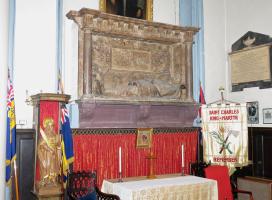
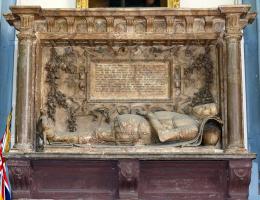
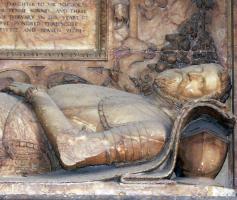
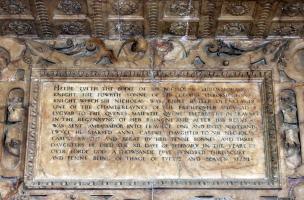
And there is another sculptural link. The inscription notes that Sir Nicholas married Anne Carewe [Carew], daughter to Sir Nicholas Carewe, ‘and begat by her tenne sonnes and three daughters’. The Carews were the dominating family of the Beddington area of Essex, now within South London, and when the heir to the family died without issue, the youngest son of Sir Nicholas’s profuse brood was adopted into the family to continue the line, taking the Carew name. There are marked similarities of the monument to Sir Francis Carew in Beddingon Church to Sir Nicholas’s one – see this page.
17th Century grand Classical panels: Ellnor, Tovey, Spencer. 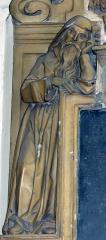
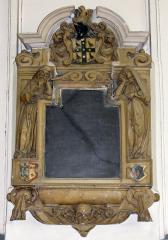
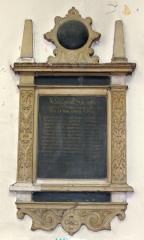
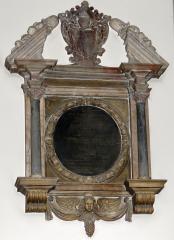
John Bacon RA's figure sculpture to Samuel Thorpe, d.1791. 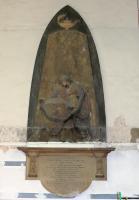
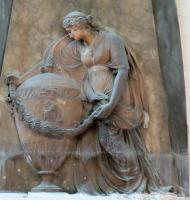
There is a panel noting that the Hanman tablet, and those to Lake, Clay, Sparks and Eddrup, were removed from the Church of St James’s Dukes Place, Aldgate, when that church was demolished in 1874 (see picture of panel and the church itself below). The panel is itself carved with slightly domed top, bevelled centres to each edge, and is on a backing panel, a little monument in itself, signed by Druitt of Mile End Road. It is surrounded with painted insignia on small panels, including London Underground.
Hinchliffe of Hamptstead carved panels: Godfrey and Mulliens. 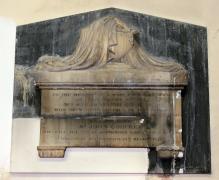
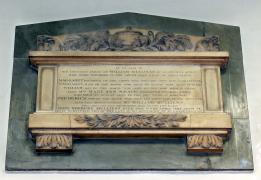
And thus the monuments in St Katharine Cree Church. John Strype, who in 1720 greatly enlarged on
John Stow’s 1598/1603 survey of London, saw other monuments there, including some 15th Century ones,
also Frances Croke, d.1605, John Smith, d.1598, and others, alongside others of the 17th Century which
are still to be seen today. Although he saw no tomb,
Strype writes that he was told that
St Katherine Cree woodwork: lectern and detail, organ carving, modern Charles I, and Royal Arms. 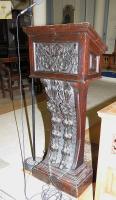
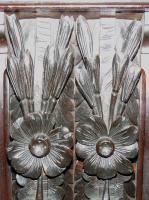
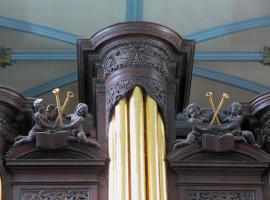

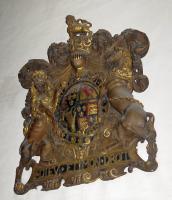
A bit of the churchyard survives, now made into a garden, and entered from Mitre Street. A couple of raised ledgers, tombstones, and a tomb chest remain, and a few broken remnants round the side, but the main feature is the stone gate, once just East of the Church on Leadenhall Street, with an inscription that it was built ‘at the cost and sole charges of William Avenon, Citezen and Gouldsmith of London, who died in December Anno D[omi]ni 1631’. Above the inscription in the deep pediment is a recumbent skeleton, his lower body wrapped in a shroud, his head raised on a rolled up mat. A macabre thing, now made into the back of a fountain, it is comparable with the surviving gates to St Olave Hart Street (skulls), and to St Giles in the Fields (Doom). Another comparison may be made with the effigy in a winding sheet on the monument to Thomas, Lord Darcy and Sir Nicholas Carew in East to St Botolph Aldgate, who were both executed as parties to some Catholic plot – a fate narrowly avoided by our Sir Nicholas Throkmorton, Carew’s son in law.
With many thanks to the Church authorities for kind permission to show pictures of the monuments inside; their website is http://www.sanctuaryinthecity.net/st-katharine/4586821914.
West to St Andrew Undershaft // and then North to St Helen Bishopsgate // East to St Botolph Aldgate // South to All Hallows Staining // or to St Olave Hart Street
Monuments in churches in the City of London // Introduction to church monuments
Angel statues // Cherub sculpture
Visits to this page from 8 Jan 2017: 6,441